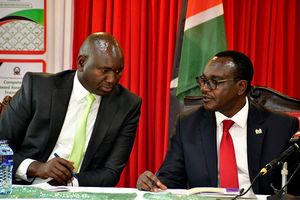Premium
Covid-19: Three million Kenyans may be infected

Health Chief Administrative Secretary (CAS) Mercy Mwangangi speaks during the Covid-19 daily briefing on August 20, 2020.
What you need to know:
- As of Thursday, the total caseload was 31,441 cases against a sample size of 407,610.
- At the beginning of the month, the Kenya Medical Research Institute had predicted that 1.6 million Kenyans had been exposed to the virus.
The Ministry of Health estimates there could be three million cases of Covid-19 in the country.
Health Chief Administrative Secretary Mercy Mwangangi explained the projection stems from the observation that 7.9 per cent of those tested are found to be infected with the virus.
“If we were to extrapolate this 7.9 per cent positivity rate, it would mean right now in the country, assuming a population of about 47 million, we have about three million cases,” Dr Mwangangi said.
An observed plateau between week 28 and week 31, she said, could indicate a peak in the rate of transmission and a steady decline in positivity rate to the current week 33, which could indicate a decreasing rate of transmission.
Despite the development, Dr Mwangangi said Kenya is yet to attain the World Health Organisation benchmark of five per cent for the infections to be said to be declining.
Decline of pandemic
“The positivity rate must remain below five per cent for 14 days, according to WHO, as a measure of decline of the pandemic,” she said.
She explained that while at the beginning of the pandemic the positivity rate was only two per cent, below the WHO benchmark, it had since risen.
“From this caseload out of the total samples, the current positivity rate is 7.9 per cent and over the last 34 weeks, this positivity rate has steadily increased from an initial two per cent at the beginning of the pandemic. This increase points to an acceleration in the rate of transmission of the disease,” she added.
According to the CAS, the increase in positivity rate points to a peaking curve.
“We are continuing to ensure that we manage the pandemic to get to the global benchmark of five percent for 14 days,” she said.
As of Thursday, the total caseload was 31,441 cases against a sample size of 407,610. At least 426 cases were reported from a sample size of 5,158.
At the beginning of the month, the Kenya Medical Research Institute had predicted that 1.6 million Kenyans had been exposed to the virus, down from 2.7 million previously predicted.
Speaking earlier in the week, Health CAS Rashid Aman said despite daily reduction of the number of infections being reported, there were many other factors that determine if infections have peaked or if the curve is dropping.
Curve is dropping
“It is a bit early to say the curve is dropping. There are other indicators that determine where we are and the strongest indicator is the number of hospitalisations due to Covid-19 and the people dying from the disease,” he said.
In the last two days, 29 people have died from the disease. Yesterday, 10 patients died, three from the community and seven from various hospitals, bringing to 516 the total number of deaths in the country so far.
It was expected that the Covid-19 pandemic would peak in August or early September.
The peak will not be seen, until Kenya is testing enough, said public health expert Bernard Muia.
Asymptomatic patients
“We have not reached there because we are using biased data, which is based on symptomatic patients, which does not give the true picture of the disease,” Dr Muia said.
He said most asymptomatic patients have not been tested, while those who have been exposed have not been contact-traced.
“We’re having a selection bias in testing; this will never show us the magnitude of the problem because the peak is going to be informed by the number of Kenyans be tested,” he argued.
According to Dr Rashid, tests are fluctuating due to lack of enough testing kits but once they are available, the tests are expected to go up.
“The number of cases that we unearth is determined by the sample size. In the last few days, the number of tests we have conducted has come down because of lack of reagents,” he said.
Speaking yesterday, Health Director-General Patrick Amoth said the reported sample sizes and a prolonged test turnaround time was because four of the laboratories doing tests had been down.
These are the National HIV Reference Laboratory, the National Influenza Centre Laboratory, the Namanga Mobile Laboratory and the dry port laboratory in Naivasha.





